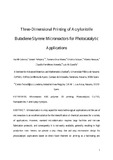Mostrar el registro sencillo del ítem
Three-dimensional printing of acrylonitrile butadiene styrene microreactors for photocatalytic applications
| dc.creator | Cabrera Barrios, Aarón | es_ES |
| dc.creator | Pellejero, Ismael | es_ES |
| dc.creator | Oroz Mateo, Tamara | es_ES |
| dc.creator | Salazar, Cristina | es_ES |
| dc.creator | Navajas León, Alberto | es_ES |
| dc.creator | Fernandez Acevedo, Claudio | es_ES |
| dc.creator | Gandía Pascual, Luis | es_ES |
| dc.date.accessioned | 2020-11-27T08:45:55Z | |
| dc.date.available | 2021-11-01T00:00:13Z | |
| dc.date.issued | 2020 | |
| dc.identifier.issn | 1520-5045 (Electronic) | |
| dc.identifier.uri | https://hdl.handle.net/2454/38795 | |
| dc.description.abstract | Miniaturization is a key aspect for many technological applications and the use of microreactors is an excellent solution for the intensification of chemical processes for a variety of applications. However, standard microfabrication requires large facilities and intricate fabrication protocols, and consequently it is not easily available, generally resulting in high production costs. Herein, we present a very cheap, fast and easy microreactor design for photocatalytic applications based on direct fused filament 3D printing as a facilitating and widespread technology. The microreactor consists of three bodies directly printed in ABS (Acrylonitrile Butadiene Styrene): a main body with a serpentine microchannel pattern where the photocatalyst is placed, a top holder with a transparent polymer window, and a base to clamp the parts. Several microreactor units were coated with TiO2 doped with Cu (2.4 wt.%) nanoparticles synthesized by FSP (Flame Spray Pyrolysis) and tested for the photocatalytic degradation of two water pollutants showing excellent performance. | en |
| dc.description.sponsorship | Financial support from Gobierno de Navarra (grant PC003-004), Spanish Ministerio de Ciencia, Innovacion y Universidades, the European Regional Development Fund (ERDF/FEDER) (grant RTI2018-096294-B-C31) and Agencia Estatal de Investigación (grant PID2019-106687RJ-I00/AEI/10.13039/501100011033) is gratefully acknowledged. I.P. thanks Obra Social la Caixa, Fundacion Caja Navarra, and UPNA for their research contracts in the framework of the program 'Captacion del Talento 2019'. L.M.G. wishes to thank Banco de Santander and Universidad Publica de Navarra for their financial support under the 'Programa de Intensificación de la Investigación 2018' initiative. | en |
| dc.format.extent | 25 p. | |
| dc.format.mimetype | application/pdf | en |
| dc.language.iso | eng | en |
| dc.publisher | ACS | en |
| dc.relation.ispartof | Industrial & Engineering Chemistry Research, 2020, 59, 47, 20686–20692 | en |
| dc.rights | © 2020 American Chemical Society | en |
| dc.subject | Microreactor | en |
| dc.subject | ABS polymer | en |
| dc.subject | 3D printing | en |
| dc.subject | Photocatalysis | en |
| dc.subject | Cu-TiO2 nanoparticles | en |
| dc.subject | Flame spray pyrolysis | en |
| dc.title | Three-dimensional printing of acrylonitrile butadiene styrene microreactors for photocatalytic applications | en |
| dc.type | info:eu-repo/semantics/article | en |
| dc.type | Artículo / Artikulua | es |
| dc.contributor.department | Institute for Advanced Materials and Mathematics - INAMAT2 | es_ES |
| dc.rights.accessRights | info:eu-repo/semantics/openAccess | en |
| dc.rights.accessRights | Acceso abierto / Sarbide irekia | es |
| dc.embargo.terms | 2021-11-01 | |
| dc.identifier.doi | 10.1021/acs.iecr.0c04349 | |
| dc.relation.publisherversion | https://doi.org/10.1021/acs.iecr.0c04349 | |
| dc.type.version | info:eu-repo/semantics/acceptedVersion | en |
| dc.type.version | Versión aceptada / Onetsi den bertsioa | es |
| dc.contributor.funder | Gobierno de Navarra / Nafarroako Gobernua, PC003-004 | es |
| dc.contributor.funder | Universidad Pública de Navarra / Nafarroako Unibertsitate Publikoa | es |


